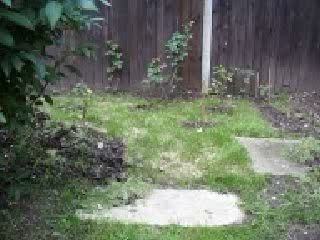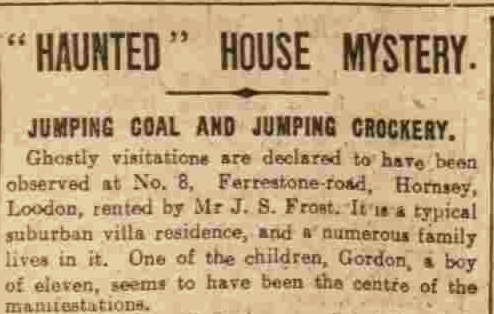The ‘Hornsey Coal Poltergeist’ is perhaps one of the lesser known ‘extreme’ hauntings of the twentieth century. Like the disturbing manifestations on the Hillcrest Estate, which is situated just one mile south west in Highgate, the Hornsey ‘ghost’ chose a seemingly innocuous suburban housing development when it allegedly began tormenting the Frost family in January 1921.

Ferrestone Road, which lies close to Hornsey High Street and Tottenham Lane, was built in the late 1900s on what had previously been church land belonging to the parish of Hornsey. Burials on the site, which is adjacent to Old St Mary’s Church Tower, had only ceased in 1894. It seems though that the residents of these new builds had little or no idea of how slapdash the builders and church authorities were in ensuring that the grounds and foundations of the houses were excavated prior to their construction.


Things began to go wrong for the extended family of Mr. Ivan Frost, a brass founder living with his wife, elderly parents, his two adult sons and three orphaned nieces and nephews, on New Year’s Day 1921. 1921 was a cold winter, and Mr. Frost purchased a normal nineteen hundredweight of coal. However, the coal shortly began to behave in an extremely unusual fashion. Interviewed by the Daily Mail on 31st Jan 1921, Mr. Frost reported:
When big lumps leapt out of the fire and broke the kitchen windows we thought some sort of explosive had got mixed up with the coal. But after other lumps smashed pictures and damaged the furniture in the dining-room, we cleared all the coal out into the garden. Last night some of it reappeared in the house, and we heard it dropping at the top of the stairs. It seemed to be moving up from below …
Policemen and members of the Fire Brigade investigated the coal, which they reported as leaping out of their hands and breaking in mid-air, but no cause was found. Then other strange things started happening. Food, clothing and small objects such as a flat iron would fly through the air and land unbroken, or be found in grates and other odd places. The family, naturally frightened, invited two local vicars and their local doctor to witness and explain what was happening, but although all three men observed the phenomena and the rapping and banging which had begun to pervade the house they were unable to offer any interpretation or resolution.
The case was reported in the local and national press for several months. Rapidly the unseen force took on a more violent and sinister nature, and instead of making plants dance on their stands and china fly from the mantelpiece, it took to throwing knives and heavy furniture at the children, as well as raising their chairs and beds some feet off the ground. The family were deeply affected by these events, especially the children, one of whom was sent to Broadstairs for the good of his health and later hospitalised suffering from nervous exhaustion. Other members of the family, unable to take the strain, quit the house altogether.

But on 30th March 1921 the Ferrestone Road haunting reached its worst and final climax, when five year old Muriel, ‘the baby of the family’ passed away after a short illness. Some sources attributed her death to meningitis, whilst others have long regarded her passing as one of the few deaths directly attributable to supernatural phenomena.
Mr. Frost when speaking to the Daily Mail two days later drew the following conclusion:
Muriel took all the phenomena with calmness until a week or so ago. But since a bedstead rose, knocking over a chair and causing her to fall and bite her tongue, she has been much scared. Just before her death the house became a mass of rappings. Early this week she was taken suddenly ill, and died on Thursday morning. We are all convinced that she has been worried into this illness.
Was the Hornsey ‘ghost’ a poltergeist as we understand the concept today; the result of a complex family dynamic which would benefit from a deeper analysis? Could the perpetrator – if supernatural in any sense – be considered to be a sentient and malevolent entity? Is the house still ‘haunted’? And what role could environmental and geographical factors play in the case? I explore this case in depth – and reveal a hitherto undiscovered twist – in my forthcoming book ‘Haunted Highgate’.
But in the meantime, here is a recently rescued (although sadly not restorable) piece of footage dating back to 1999, in which David Farrant of the British Psychic and Occult Society interviews the present occupant of the house, referred to here as ‘Pauline’.

While the audio recordings of rappings are not held up as incontrovertible evidence of psychical phenomena, especially considering the capture of the sound of building work during outdoors filming earlier in the footage, the three members present and ‘Pauline’ were convinced that what appear to be somewhat responsive rappings were coming from the centre of the room and had no rational causation.

